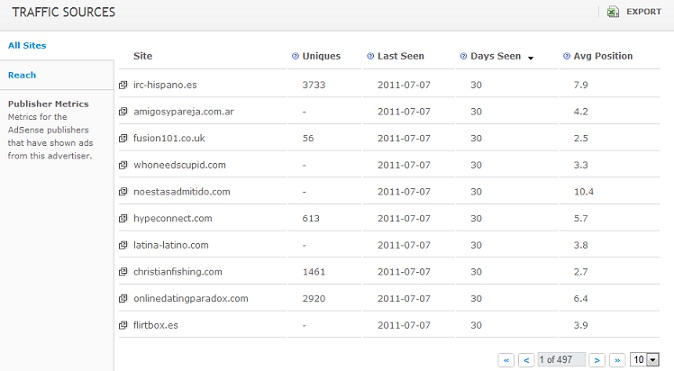Where Next For Facebook’s Refugee Affiliates?
Have you been noticing a drop in impressions delivered to your Facebook campaigns? It seems many advertisers have, myself included, and these changes are reflected in a brand new report that illustrates just how quickly the cost of a click is rising.
Facebook’s cost-per-click rose by 22% in the second quarter, having already jumped 40% in the first, according to Efficient Frontier’s findings.
To put that in perspective, you’re spending $8.54 for the same number of clicks as you received while paying only $5 seven months ago. For affiliates like yours truly who thrive in the dating vertical, these numbers are now entering dangerous territory.
Either the payout on a lead rises, our marketing efforts improve considerably, or we flock elsewhere for cheaper traffic of a similar quality. In a dream world, all of those scenarios playing out would be very welcome indeed. But let’s be realistic.
The report, biased as it may be, suggests click prices are set to rise by a colossal 80% in 2011 alone. That’s good enough reason to foresee a mass arrival of Facebook affiliate refugees on other traffic sources.
If you’re already twitching at the lower margins, now would be a good time to broaden your horizons.
I’ve stressed this before, and I’ll stress it again. International markets represent the best opportunities for affiliates on Facebook. The reason click prices are spiraling can be attributed to a crowded marketplace. In America, every small business is rushing to get a presence on Facebook Ads. I blame those arsehole ‘social media consultants’, quite frankly.
However, by straying away from America and the UK, you can find markets that are less crowded and still viable for the majority of affiliate campaigns.
Social Bakers has a useful chart listing the average Facebook click prices per country. Norway tops the list with a average CPC of $1.60 (ouch), while the Central African Republic boasts an average of just $0.07 (about 1000% of the maximum I’d be willing to pay!)
Let’s assume that you’ve explored all international options. The click prices are still too expensive and you need to find new inventory fast. What’s your next move?
If you’re feeling brave, you can use the AdBrite Site Directory to target Facebook apps traffic. The platform lets you advertise not just on Facebook, but on a whole bunch of other mainstream websites. I’ve had some profitable campaigns running through AdBrite, but be prepared to work for them if you choose this route.
There’s also Cubics – now known as Adknowledge Super Rewards. I know, right? What a shitty name for an ads platform. Somebody’s branding brainfart clearly got taken too seriously. Cubics lets you advertise to apps users on Facebook, MySpace, Bebo and Friendster.
Speaking of Friendster, did you know that it used to have it’s own self-serve ads platform?
Did anybody try it?
I can visualise seven raised hands, the happy owners of about 42 combined impressions during the entire fucking lifecycle of that particular ads platform.
RIP Friendster Ads. My balls mourn your demise.
Cubics has a pretty clunky interface and the reporting leaves much to be desired, but it holds potential for the right type of offers. In any case, I appreciate poor aesthetics. They cast an aura of shiteness that helps keep heavy competition at bay.
If you’ve ever tried to monetize apps traffic, you don’t need me telling you that it’s a damn sight harder than the self-serve inventory on Facebook. Expect to be kept busy with plenty of rounds of testing before you find the magic formula where both volume and profitability thrive in tandem.
Of course, you may find it easier to simply abandon Facebook completely.
The ‘Book is just one of many social networking hubs. And while I’m sure a large number of affiliates will be waiting with bated breath for a Google+ ads platform (and to find out if they’re already banned from it), you can keep yourself busy by browsing this list of popular social networks.
If you’re sick and tired of spiraling click costs, do yourself a favour and browse through the alternatives. They’re certainly in no short supply.
Visit the sites that match your target market, scroll to the bottom of the page and nine times out of ten, you will find a link titled “Advertise”. It sounds like I’m being sarcastic, but it never ceases to amaze me how many affiliates have link-blindness to this sitting duck of an opportunity.
You can undercut 95% of affiliates by simply getting off your arse and making the effort to venture beyond self-serve ad platforms. Negotiation, a budget and being proactive can restore your margins in no time at all.
Recommended This Week
Lots of Ads is the latest service to offer spying capabilities over Facebook’s most profitable ads. The great appeal for me is the ability to spy on International markets including France, Spain, Argentina, Brazil and many more. Save time on translations and tap in to the most lucrative markets on Facebook. Definitely a worthy addition to your toolkit. First 20 customers only who use code FINCH11 will receive 10% off their lifetime subscription. Enjoy!
Published today on Direct Response was a piece I wrote titled “It’s Time To Cull Some Internet Marketers“. I think I was in a shitty mood when I splurged it, but I stand by the points raised. Direct Response is a fantastic blog, by the way, one of my favourites in the biz and a must-subscribe-to if you’re not already reading it.
If you’re a new reader, please add me to your RSS. You can also follow me on Twatter if that’s your kinda thing.


Google+ has without a doubt a large advantage to the social sharing world. They get to learn from other's mistakes.…